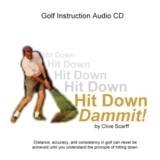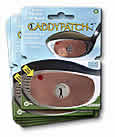The Short Game Part 3: Putting Alignment
& Reading
Read
other Parts from the
Technology & Distance
series and Short Game
series here, Archives.
If you'd
like one on
one explanations
about the topic,
sign up for the PGI
Member Select Club and
I'll answer all your
questions in a prompt,
thorough fashion.
Now on to this week's
topic.
III. How
many putts do
you miss due to
mis-reading? due
to mis-alignment?
Statistically,
putting is the
most important
aspect of the game.
The lower your
handicap, the more
important your
putting is to your
score. The most
important aspects
of putting are
the ability to
reading the break
in a green and
alignment. If you
think you're aligned
properly along
the correct line
and you're not,
you'll most likely
miss the putt and
have incorrect
feedback (think
there is something
wrong with your
stroke).
Take
the analogy of
shooting with a
rifle. If the sight
of the rifle is
mis-aligned, it
will be very difficult
to hit your target
without somehow
compensating. For
example, let's
say the sight is
aligned so that
the rifle is aimed
left of the target.
If you have good
aiming mechanics,
you'll hit your
shots left of the
target. You'll
need to start aiming
to the right or
adjusting your
mechanics to hit
hit the target.
In
putting, if you
aim too far left
or right of the
correct line with
good putting mechanics,
you'll miss the
putt. After a number
of misses, your
body will begin
to adjust the stroke
to get the ball
on line. Your mechanics
will change without
you really knowing
about it.
All
golfers mis-align
their putts. All
golfers under-read
their putts. This
is the major reason
for the low one-putt
statistics (a
graph will open
in a new window)
on longer putts.
I've
written
an article
on this subject
where I reference
some studies done.
View it here.
How
do you align properly?
I was surfing the
net and found some
very good articles
that will help
you align properly.
One uses floor
tiles as a
guide. Another
is Putting
Alignment is Your
Best Friend
There
are a number of
putting aids
that you can
purchase to help
your alignment
and your stroke
as well.
I
would suggest you
buy a putter
that helps you
with your alignment.
There are a lot
of different
models out there.
You want one that
feels good, is
well balanced and
helps you align
better. Below are
pictures of two,
the Odyssey and
the Scotty Cameron.
  |
Putters
like these assist
the golfer in
aligning correctly
by having a visual
line that the
golfer can line
up with the ball
and the hole. |
Once
one is able to
align the putter
more successfully,
the next important
factor is to know
what line to use.
One requires the
ability to read
the amount of break
in the putt. All
golfers tend to
under-read the
amount of break,
even professionals.
The craft of reading
greens is both
an art and a science.
Dave
Pelz says it very
well in his book,
The Putting Bible: " If
you don't listen
up and pay attention
concerning this
problem ..",
(putting alignment), " ..
improving the other
14 building blocks
of putting discussed
is this book won't
do you much good."
I
have a 2 handicap.
I am considered
to be a very good
putter by others
at my club. I credit
much of my putting
success to my ability
in reading greens
correctly. I rarely
under-read putts,
although I still
have my share of
hitting off my
intended line.
I use the Plumb
Bob method, although
I have quantified
it.
Many
very good golfers
and instructors
will argue that
one can't determine
the amount of break
with a plumb bob,
only which way
the putt breaks
(others will even
argue that you
can't tell that
either). I have
quanitified the
amount of break
from a plumb bob
read by using physics
and math to model
how a putt rolls
on a sloped green.
The
key to good
plumbing is ensuring that
your eye (most
use their dominant
eye), the ball
and the hole are
on the same, straight
line. This is very
difficult to do
accurately in one
attempt. You can
easily move your
head right or left
and get totally
different readings.
I usually plumb
a
putt 2
or 3 times.
The
amount of break
depends on the
plumb read, the
length of the putt
and the speed of
the putt (slow,
medium or fast
greens). I used
my physics/math
model to develop
a matrix that tells
how much a putt
will break depending
on the above.
For
instance, if the plumb
reads 2 inches
right of the hole,
that doesn't mean
that one should
aim 2 inches right
of the hole to
allow for a right
to left break.
One must aim much
farther right.
My matrix will
tell you how much.
Take a look at
part of my matrix
here.
I'm
not advocating
my plumb method
as the sole technique
of reading greens.
you also need to
observe the contours
of the green. My
matrix only applies
accurately to putts
where the slope
is constant. Sometimes,
we have putts that
start out on a
steep slope and
then end on a less
steep slope, and
vice versa. And,
of course, you
need to become
an accurate plumber
so apply it successfully.
Most
golfers that I
play with (and
most golfers in
general) do not
read greens well.
There is a lot
of guessing. I'm
advocating a method
that everyone can
learn and become
proficient. As
I said at the beginning
of this article,
reading greens
is art and science.
If you just don't
have a lot of talent
in art, then apply
the science.
Some
other articles
on plumbing from
other sites: Plumb
Bob by Justin Leonard
Golf
Tips Magazine -
How to plumb putts Plumbing
Fallacies
Next
time, I'll provide
you with even more
great tips dealing
with how to read
putts. Remember,
putting is the
most important
part of the game.
To putt well, one
must first be able
to read the correct
line for a putt
and then align
properly.
Purchase
my Longest
Golf Ball Report (over
280 sold so far)
in which I statistically
analyze
distances
of over 70 different
golf balls with
differing constructions.
The balls were
hit
using a mechanical
hitting machine.
Play
with my Driver
Distance Calculator.
You can input such
variables as loft
and clubhead speed
to determine the
optimum loft. I'll
be adding to it
soon so that you
can input different
golf ball parameters
such as speed and
spin.
A list of resources that have been used to produce this newsletter
can be found on my
website here.
The next newsletter's topic will be on reading putts (break
and distance). If you
have any questions ahead of
time, send me an email.
The focus
of my site
is to utilize science
and math to lower
your score. New technology
is one
way to achieve this,
but to be honest,
the technology is
one small piece of
the puzzle.
To actually improve significantly,
we all need to:
1. Improve our swings using CD
Interactive, Hit
Down Dammit!
2. Learn how to swing simpler
like the Iron Byron
with the great coffee
table book, Swing
Machine Golf!
3. Improve our physical fitness
and strength.
The
Golf Trainer Power
Performance Programô
4. Improve our mental games.
Golf
Mind Software
5. Improve our Probable
Golf games.
Learn how to make better
choices on the course
through knowing how
shot patterns and reading
the elements and course
better.
Click on the links above to
take a look at
ways that I personally
use myself and
recommend you try
as well.
Hope
I provided some useful
ways for to become
better prepared for
you best golf season
ever.
Ken Tannar
If you'd like to opt out of this newsletter, send
me an email with the subject "opt
out, please"
|











